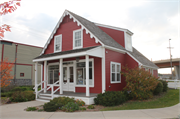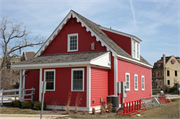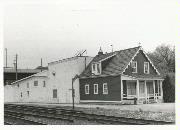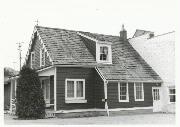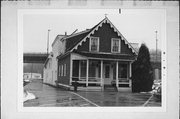Property Record
7720 W HARWOOD AVE
Architecture and History Inventory
| Historic Name: | Dr. Levi C. Halsted Building |
|---|---|
| Other Name: | The Little Red Store |
| Contributing: | |
| Reference Number: | 8926 |
| Location (Address): | 7720 W HARWOOD AVE |
|---|---|
| County: | Milwaukee |
| City: | Wauwatosa |
| Township/Village: | |
| Unincorporated Community: | |
| Town: | |
| Range: | |
| Direction: | |
| Section: | |
| Quarter Section: | |
| Quarter/Quarter Section: |
| Year Built: | 1854 |
|---|---|
| Additions: | |
| Survey Date: | 19952016 |
| Historic Use: | post office |
| Architectural Style: | Front Gabled |
| Structural System: | Timber Frame |
| Wall Material: | Clapboard |
| Architect: | |
| Other Buildings On Site: | |
| Demolished?: | No |
| Demolished Date: |
| National/State Register Listing Name: | Not listed |
|---|---|
| National Register Listing Date: | |
| State Register Listing Date: |
| Additional Information: | A 'site file' exists for this property. It contains additional information such as correspondence, newspaper clippings, or historical information. It is a public record and may be viewed in person at the Wisconsin Historical Society, Division of Historic Preservation. Frame clapboard structure was early social, political, and economic center for Wauwatosa. Moved in 1950. It was built in 1854 near a mill on the Menomonee River that first established Wauwatosa as a pioneer center for commerce. It also was at the intersection of the state's first rail line and tender shoots of a plank road that criss-crossed southeastern Wisconsin. The Little Red Store has been extensively renovated by the Wauwatosa Historical Society. Physician Levi Halsted built the store. He and his wife Harriet had moved form New York to Wauwatosa in 1848, where he bought land and established his medical practice. Halsted sold the building in 1855 and, at some point after his wife died, "rented the chamber over the store, set up his drugs and office furniture in the front room, placing his bed in the rear chamber; sometimes boarding out, sometimes boarding himself," according to a 1902 history. Halsted's wife died in 1856 and he enlisted in the Union army in 1861 and again in 1862, serving as a surgeon until 1863 or 1864. After his discharge, he moved to Wauzeka in Crawford County. The building's second owner, Thomas M. Riddle, remodeled it for use as a store. Riddle served as postmaster and as station agent for the Chicago, Milwaukee & St. Paul Railroad. When Halsted went off to war, he left behind an unusually large collection of books. In effect, that created yet another role for the Little Red Store as the village's first circulating library. The first known photograph of the store is from 1870. The roof over the porch was flat and the upper level had a single window and a door. Riddle died in 1869 and his son took over the business, but sold the building in 1873 to Leander L. Gridley. Grindley's son, Lysander, ran the store and, like the Riddles, also served as station agent and postmaster. The building's multiple uses brought criticism from the Milwaukee Sentinel. "Now we like variety, but this is a little too well mixed." the Sentinel editorialized in 1874. When a depot was built in 1880, Lysander Gridley gave up his position as station agent but continued running the store and serving as postmaster. The village fire of 1895 destroyed most buildings in the eastern half of the business district. The Little Red Store was spared because it was south of the river. Gridley rented out the store by no later than 1892 and in 1896 started an insurance business in an adjacent two-story building that also housed a hardware business, Bump & Bossingham. From 1898 to 1904, Gridley was also editor of the Wauwatosa News, working out of that building. Gridley's tenant in the Little Red Store was Frederick H. Bark, an upholsterer and furniture repairer. The business was in the front and the family of five lived in the back and upstairs. The family and the business moved out in 1901. Little is known of the occupants between 1901 and 1904, but a 1902 advertisement indicates that W.B. Morse, a dealer in flour, feed, grain and hay, then operated at the store. In 1904, Gridley had moved his insurance business back to the Little Red Store. A 1905 photograph shows that the flat porch roof had been replaced with a pitched roof and the upper-level door had been replaced by a window. A fire insurance map shows that plumber Frank Mueller shared the building with Gridley in 1910. By 1920, Mueller has passed the business on to family member Joseph J. Mueller. The plumbing business stayed until the Jacobus bought the building in 1955. A picture form 1914 shows a dormer had been added along the north side. In the 1940s, while the building was owned by Gridley's children, a second dormer was added. Signs shows in the 1914 picture advertise the Wauwatosa Harness Shop. The proprietor, Joseph Reisman, shared the space with Mueller and Gridley. Morse's business also is identifiable in the picture, although it had expanded by then to also sell fuel and cement. Morse's business was in the adjacent building. Other tenants during the Gridley family's ownership include Wauwatosa Ice and Coal Delivery, from about 1929 to about 1936; the Master Glaze Company, from about 1941 to about 1949; as well as the Uneeda Shine Parlor and J.I. Cronin Co., electrical contractors, both in about 1949. Also sharing this address in 1922 was the Wauwatosa Fuel and Supply Company, now known as the Jacobus Quickflash Heating and Cooling services. Charles C. Jacobus had purchased W.B. Morse Coal and Fuel Supply in 1919. Its offices were moved in 1924 to an office built by Jacobus at 770 W Harwood Ave. The Jacobus Company, which had its large fuel tanks behind the Little Red Store, bought the building in 1956 to gain driveway access for its trucks. In 1961, the Little Red Store was moved onto a new foundation 50 yards to the west and Jacobus spent $14,000 on its restoration. In its new location, it was joined to a former electric power plant. The new basement included a kitchen, employee break room, and restrooms. The company had grown by the late 1970s and then employed more than 125 people, owned more than 100 delivery trucks and stored up to 35 million gallons of fuel in tanks along side the rail tracks. A 1977 derailment nearby prompted thoughts about relocating and, ten years later, Jacobus sold the 2.5 acre lot and donated the Little Red Store to the city in hopes it would remain a landmark. In 1982, the Harmonee Bridge was built to allow state highway motorists to cross the railroad tracks and the Harwood bridge was replaced with a pedestrian bridge. From 1987 through 1998, the city rented out the building. The last tenant, Harwood Engineering, occupied it from 1993 to 1998. The city rode down the power plant building in 2001 and covered the back wall of the Little Red Store with plywood. Electrical and water connections were severed, and the store sat vacant. Land where the fuel tanks stood was declared a brownfield, capped, and turned into a public parking lot. The Front Gabled style Dr. Levi C. Halstead Building, otherwise known as the little red store, was constructed in 1854 at the intersection of the Plank Road, Menomonee River, and the new railroad line. Intended as a dwelling for Dr. Halstead, the building was quickly adapted as the local railway depot and post office. The Halstead Building was purchased by Thomas Riddle and used as a grocery in addition to its postal and railway functions by 1856. The building was sold again to Lysander Gridley in 1873, who operated a small circulatory library from the location. At one time the small building served as a general store, express office, library, local Republican Party headquarters, harness shop, grocery, and plumbing shop in the late nineteenth century. Dr. Levi Halstead later returned to live in the building and use it as a doctor’s office in the 1870s and 1880s. The Wauwatosa Fuel and Supply Company, owned by D.C. Jacobus, purchased the building to improve access to their nearby property and moved the building from its site a short distance to the west in 1950. The small building was also renovated at this time. The building was acquired by the Wauwatosa Historical Society in 2005, and extensively renovated the following year. |
|---|---|
| Bibliographic References: | ZIMMERMANN, RUSSELL "THE HERITAGE GUIDEBOOK" (HERITAGE BANKS 1976) Wauwatosa News Times 2/19/2004. Wauwatosa Landmark, Wauwatosa Landmarks Commission, 1994. Historic Wauwatosa newsletter: May 2009, Wauwatosa Historical Society, Inc. Wauwatosa Landmarks. Wauwatosa, WI: Wauwatosa Landmark Commission, 1994. |
| Wisconsin Architecture and History Inventory, State Historic Preservation Office, Wisconsin Historical Society, Madison, Wisconsin |

